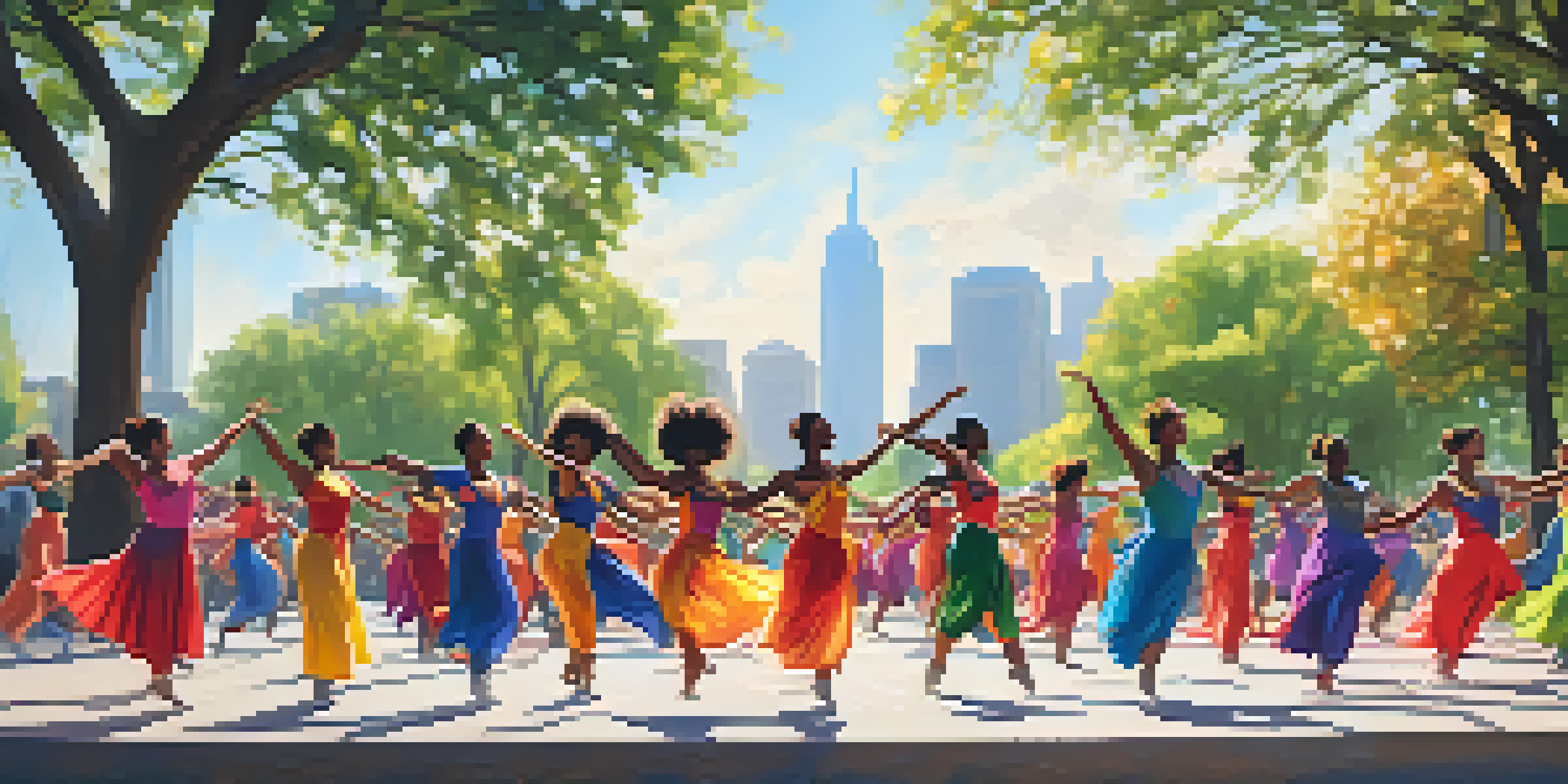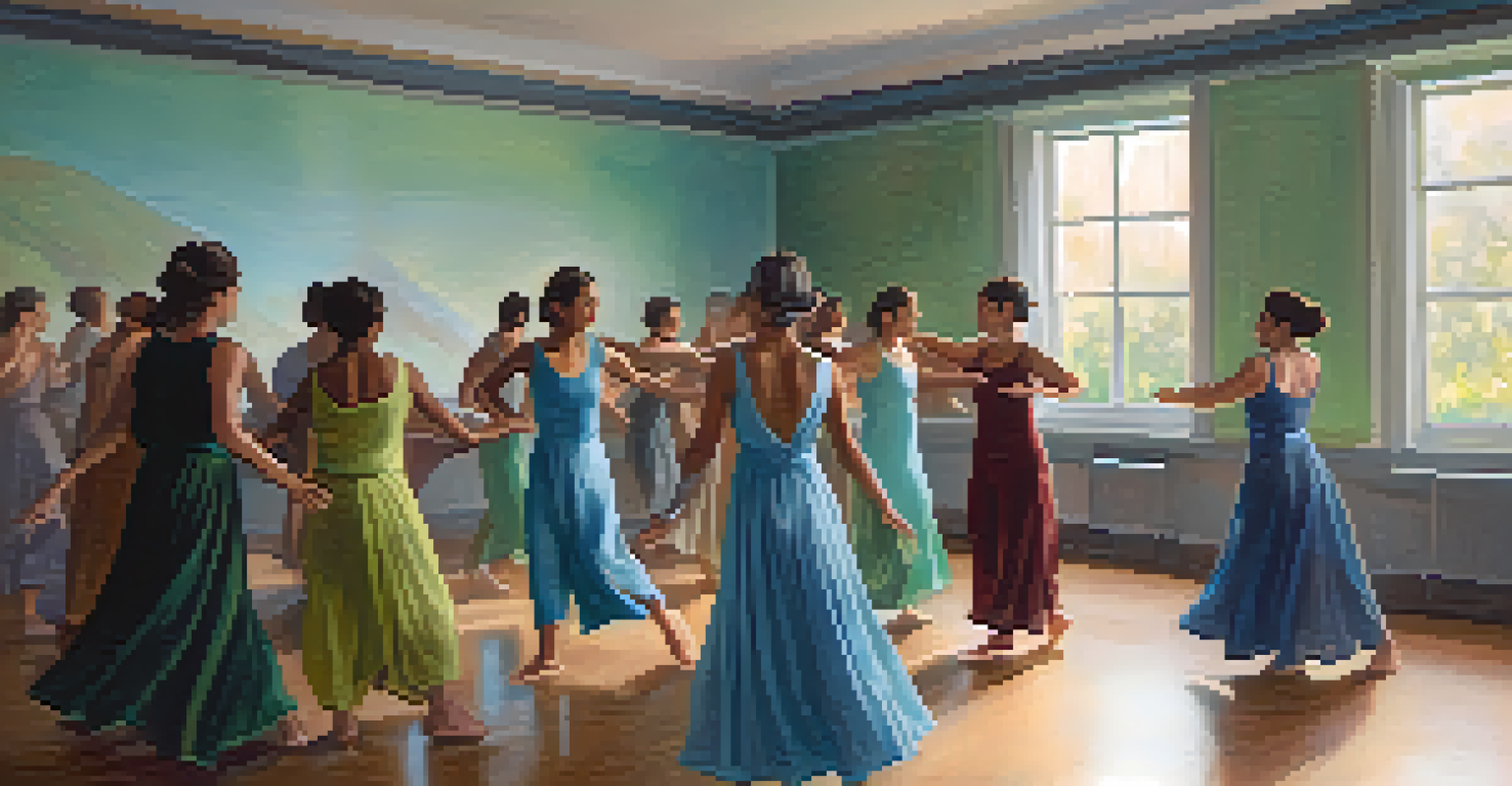Dance and Activism: Choreographing Change in Society

The Intersection of Dance and Activism: A Powerful Duo
Dance has always been a form of expression, but when paired with activism, it transforms into a potent tool for social change. Through rhythm and movement, dancers communicate messages that words often can't fully capture. Think of it as painting a picture with your body, where each gesture conveys a story of struggle, hope, or resilience.
Dance is the hidden language of the soul.
Throughout history, various dance forms have been used to address societal issues, from the civil rights movement to contemporary climate activism. For instance, performances that depict the struggles of marginalized communities can shine a light on injustices and inspire action. This artistic medium transcends language barriers, making it accessible to diverse audiences.
As dance continues to evolve, it remains a dynamic force for activism, inviting individuals to engage not only as spectators but also as participants. This participatory nature fosters a sense of community and shared purpose, reinforcing the idea that everyone has a role in driving social change.
Historical Examples of Dance as Activism
Looking back, there are numerous examples where dance has played a pivotal role in activism. One notable instance is the 'Black Arts Movement' of the 1960s, where artists combined dance, music, and visual arts to challenge racial injustice. This fusion of art forms created a powerful platform for African American voices to be heard.

Another significant example is the 'Ballet for Life' initiative, which emerged in response to the AIDS crisis. This project united dancers from various backgrounds to raise awareness and funds, blending artistry with activism in a moving tribute to those affected. It showcased how dance can invoke empathy and foster a collective response to pressing social issues.
Dance as a Voice for Change
Dance transcends language barriers, enabling artists to communicate powerful messages about social issues and inspire collective action.
These historical instances highlight that dance is not merely a form of entertainment; it has the potential to spark conversations and inspire movements. By reflecting societal challenges through choreography, dancers encourage audiences to confront uncomfortable truths and take action.
Modern Dance Companies Leading the Charge
Today, many dance companies are at the forefront of using their art to address social issues. For instance, the 'Alvin Ailey American Dance Theater' has consistently highlighted themes of African American culture and social justice in their performances. Their works often inspire audiences to reflect on the historical context of race in America.
Art is not a mirror held up to reality, but a hammer with which to shape it.
Similarly, the 'Ririe-Woodbury Dance Company' in Utah has made waves with performances that tackle themes of mental health and community resilience. By integrating contemporary issues into their choreography, they create a platform for dialogue and understanding, proving that dance can be a catalyst for change.
These companies exemplify how dance can be harnessed as an actionable force in society. Their commitment to addressing critical issues through movement not only entertains but also educates and empowers audiences to engage with the world around them.
Grassroots Movements: Dance in Local Activism
While large dance companies gain attention, grassroots movements also play a vital role in using dance for activism. Local communities often organize flash mobs and dance workshops to raise awareness about pressing social issues, such as climate change or gender equality. These events create an inclusive space for discussion and action.
One such movement is the 'Dancing for a Change' initiative, where community members come together to perform choreographed pieces in public spaces. This approach not only raises awareness but also fosters a sense of unity and empowerment among participants. It demonstrates that anyone can be a changemaker through dance, regardless of their background or skill level.
Grassroots Dance Movements Thrive
Local communities are harnessing the power of dance through grassroots initiatives to raise awareness and foster unity around social justice.
By engaging local communities, grassroots movements highlight the importance of collective action. Through dance, individuals can express their concerns, celebrate their identities, and inspire others to join the fight for social justice.
Dance as a Tool for Healing and Empowerment
Beyond activism, dance serves as a powerful tool for healing and personal empowerment. Many organizations use dance therapy to help individuals cope with trauma, providing a safe space for self-expression. This therapeutic aspect underscores the profound connection between movement and emotional well-being.
For those affected by social injustices, dance can be a liberating outlet. Programs like 'Dancing with the Stars' for survivors of domestic violence not only provide a creative escape but also foster a sense of community and support. Participants often find strength in sharing their stories through movement, reclaiming their narratives.
By emphasizing healing through dance, we recognize its multifaceted role in activism. It's not just about raising awareness; it's also about nurturing the human spirit, empowering individuals to find their voices and advocate for change.
The Role of Technology in Dance Activism
In our digital age, technology has become an essential ally for dance activism. Social media platforms allow dancers to share their messages with a global audience, amplifying their voices and causes. Viral dance challenges, for example, have sparked conversations about social justice, engaging younger generations in activism.
Virtual performances and online workshops have also emerged as effective ways to reach wider audiences, particularly during the pandemic. Dancers have utilized platforms like Instagram and TikTok to showcase their choreography while addressing important issues, creating a sense of community in a digital space.
Healing Through Dance Therapy
Dance serves not only as a form of activism but also as a therapeutic tool, helping individuals cope with trauma and empowering them to share their stories.
This intersection of dance and technology highlights the adaptability of activism in the modern world. By leveraging these tools, dancers can continue to inspire change and encourage participation, regardless of physical barriers.
Looking Ahead: The Future of Dance and Activism
As we look to the future, the relationship between dance and activism is likely to become even more intertwined. With ongoing societal challenges, dancers will continue to use their art to advocate for change and raise awareness about critical issues. Emerging artists are already exploring innovative ways to merge technology and choreography in their activism.
Moreover, as conversations around social justice evolve, dance will remain a vital medium for expression. It has the unique ability to capture the complexity of human experiences, making it a powerful vehicle for change. Future generations of dancers will likely find new and creative ways to address the pressing issues of their time.

In essence, the future of dance and activism is bright, promising a dynamic landscape where movement continues to inspire, heal, and create lasting impact. By embracing this synergy, we can look forward to a world where art and activism dance hand in hand toward a more just society.